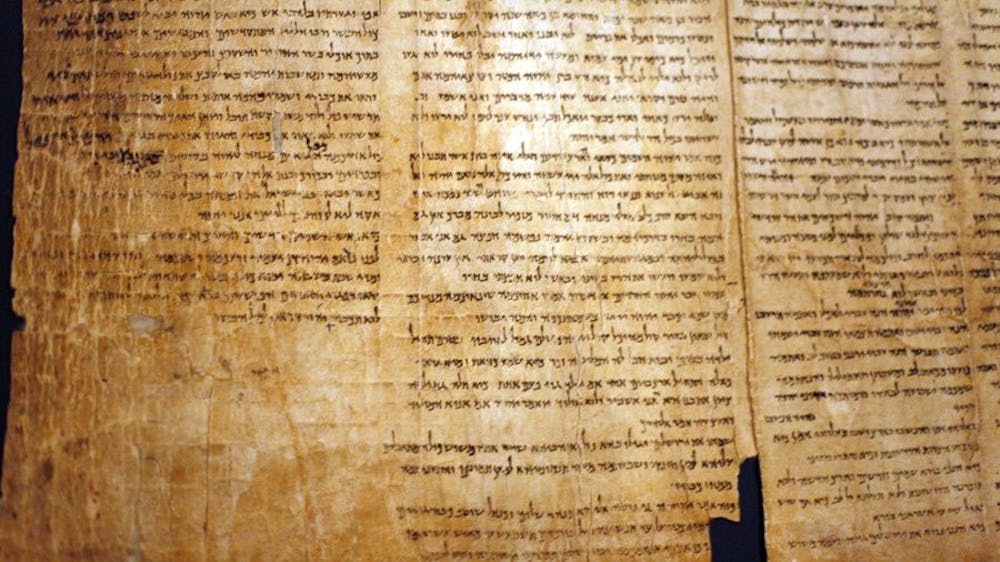Two thousand years ago, along the shores of the Dead Sea in the Judean Desert, a group of scribes left a series of religious writings in eleven remote caves, never returning to them for retrieval. Known today as the Dead Sea Scrolls, for the first time in history, these ancient and religious documents are being displayed at the Denver Museum of Nature and Science, courtesy of the Israel Antiquities Authority.
A group of UNC students affiliated with UNC’s History Club/Phi Alpha Theta went to Denver two weeks ago to view this exhibition. Referred to as the greatest manuscript discovery of all time, the Dead Sea Scrolls constitute a series of ancient and Jewish religious texts, mostly Hebrew, found in the Qumran caves along the Dead Sea between 1946 and 1947.
UNC History Club President Drew Heiderscheidt explained why the group made their convoy to Denver.
“We chose to see the Dead Sea Scrolls, because they are important historical artifacts and are not going to be here for much longer,” Heiderscheidt said. “It was a worthwhile experience and a great way getting people to know each other.”
Found at the cultural crossroads of Israel, where people of Africa, Asia and Europe have interacted for centuries, these scrolls are invaluable to humanity’s understanding of the history of Judaism, the development of the Hebrew Bible and the emergence of Christianity. The beliefs, material culture and invading and nomadic lifestyles have intermingled for millennia to shape the dynamics of this small parcel of terrain situated between the Arabian Desert and the Mediterranean Sea.
Dr. Risa Levitt Kohn and Deborah Ben Ami, distinguished researchers and editors, describe this discovery in a Dead Seas Scrolls guidebook.
“These two-thousand year old parchments and scraps of parchments demonstrate that in the day of Hellenic and Roman control of Judah and the Land of Israel, the Hebrew Bible was already a highly regarded collection of writings upon which the people of Israel relied to understand their history and relationship with their God,”says the guidebook.
Made out of a variety of material - mainly papyrus - these ancient texts comprise some 900 documents, many in tens of thousands of fragments. Although most parchment and papyrus writings tend to disintegrate as years pass, these documents in particular - discovered in jars, survived thanks to the hot and dry climate and the darkness provided by these below-sea caves.
“The goods of the holy men who walk in perfection…must not be confused with the gods of the men of deceit…” said one fragment concerning the Community Rule, or the “Manual of Discipline.” This manual was set of rules in which the Yahad--Hebrew for “unity” or “community”--lived their lives. This fragment represents just one out of many which could be viewed at this exhibit.
Although little information is known outside what has been provided this far, such as authorship and historiography, scholars agree that the authors themselves were intimately familiar with Jerusalem and resided in the city at one point or another. The passage also reveals how the authors used the term “Yahad” as a way of self-referencing, using their environment as a way to spiritually and physically withdraw from what they perceived as religious corruption in their Jewish community.
It is from this observation which leads many historians and scholars to conclude that these scrolls originated from a community of Jewish ascetics known as the Essenes, who devoted their entire lives to writing and preserving sacred texts, however, this theory is often disputed.
Whoever the authors were they, nevertheless, believed these texts had some significance – at least enough that they should be preserved for safe-keeping. Because of their conscientious effort to keep the documents safe, these texts are now the oldest existing copies of the Hebrew Bible today, composed when Judaism and Christianity began taking form.
The exhibit itself is divided into five sections, each with their own unique atmosphere. As visitors examine each room, a cornucopia of artifacts including, but not limited to, pottery, architecture and coins catches the viewer’s attention.
Each room has similar characteristics as well. There is generally some sort of walkway where guests can view a line of artifacts, relics and objects related to ancient Israel and the Scrolls. Anything imaginable related to Middle Eastern life can be found here: leather sandals, food, religious jewelry, stones and pots are to just name a few of these articles from the past. The Dead Sea scrolls, however, represent the oldest artifacts in the museum.
“In terms of history, this is the largest exhibition ever shown in the states,” Debora Ben Ami said, who is the senior curator for the Iron Age and Persian periods at the IAA’s National Treasures Department. “This time we wanted to tell the complete story, from the present back to the emergence of the Israelites in the 12 century BCE.”
No two rooms are exactly alike in terms of layout, treasures displayed and context provided. In the second room, for example, the museum gives information about the latest technologies collecting, analyzing and storing these documents. In 2011, the Israel Antiquities Authority announced a partnership with Google creating an online searchable database of images of the Dead Sea Scrolls, including text translations and other scholarly features.
The IAA, using this technology, will photograph every scroll for the first time since the 1950s. This cutting edge, multi-spectral imaging technology developed by NASA provides high-resolution of these fading texts.
The exhibit will be open until September. In June, the scrolls will be returned to Israel and replaced by another set of ten. Upon returning, they will be stored in total darkness, resting without their cases for at least the next five years.








